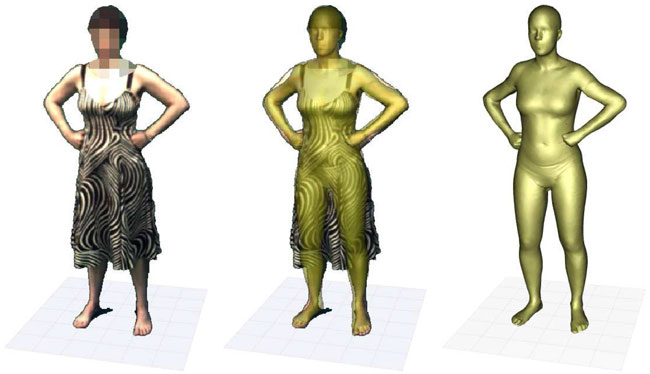New Scan Detects Body Shape Under Clothes

Imagine you are a police detective trying to identify a suspect wearing a trench coat, baggy pants and a baseball cap pulled low or a fashion industry executive who wants to market virtual clothing that customers of all shapes and sizes can try online before they purchase.
The main obstacle to these and other goals is creating a realistic, computerized 3-D body shape — especially when the figure is clothed or obscured.
"If you see a person wearing clothing, can the computer figure out what they look like underneath?" said Michael Black, a computer scientists at Brown University.
Black and graduate student Alexandru Balan have figured out how to solve that puzzle. They created a computer program that can accurately map the human body's shape from digital images or video (see what the scan does). This is an advance from current body scanning technology, which requires people to stand still without clothing in order to produce a 3-D model of the body.
With the new 3-D body-shape model, the scientists can determine a person's gender and calculate an individual's waist size, chest size, height, weight and other features.
Black and Balan presented their findings this month at the European Conference on Computer Vision in Marseilles, France.
Besides benefiting forensics and fashion, Black and Balan's research could help the film industry. Currently, actors must wear tight-fitting suits covered with reflective markers to have their motion captured. The new approach could capture both the actors' shape and motion, while doing away with the markers and suits.
Get the world’s most fascinating discoveries delivered straight to your inbox.
In sports medicine, doctors would be able to use accurate, computerized models of athletes' bodies to better identify susceptibility to injury.
In the gaming world, it could mean the next generation of interactive technology. Instead of acting through a character, a camera could track the user, create a 3-D representation of that person's body and insert the user into the video game.
The key to the new technology was when Black and Balan realized they could divine clues about a person's shape, even when the person was wearing clothes. They created a computerized body model from 2,400 detailed laser scans of men and women in minimal clothing. They found that by combining information from a person in multiple poses, the computer was able to infer the gender of the person and the 3-D body shape.
"As I move, my clothes become loose or tight on different parts of my body," Black said. "Each pose gives different constraints on the underlying body shape, so while a person's body pose may change, his or her true shape remains the same. By analyzing the body in different poses, we can better guess that person's true shape."
Black and Balan say not to worry though, as the technology isn't like X-ray specs — it can't really see through your clothing.
- Video: The Naked Truth Under Clothes
- Wild Technologies: The Next Step With Richard Hart
- 10 Technologies That Will Transform Your Life
 Live Science Plus
Live Science Plus






